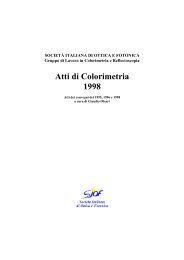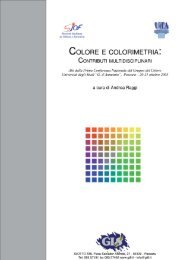Scarica gli atti - Gruppo del Colore
Scarica gli atti - Gruppo del Colore
Scarica gli atti - Gruppo del Colore
You also want an ePaper? Increase the reach of your titles
YUMPU automatically turns print PDFs into web optimized ePapers that Google loves.
optical and mechanical dot gain, is usually taken as a parameter in the mo<strong>del</strong> fit<br />
optimization. Alternative approaches describe the spreading of the ink, as proposed<br />
by Emmel and Hersch [3, 4], and by Gustavson [5].<br />
We have adopted the Yule-Nielsen modified Spectral Neugebauer mo<strong>del</strong> for binary<br />
printer characterization. The parameters of the YNSN mo<strong>del</strong> are usually computed<br />
with regression-based methods. The Yule-Nielsen n-value may be derived from an<br />
exhaustive procedure of error minimization between the measured and the<br />
predicted spectra of a set of colors, where n varies over a limited range of values.<br />
Dot gain functions can be estimated before [6], or after [1, 7] the n-value<br />
optimization. In a context in which the physical meaning of the Yule-Nielsen nvalue<br />
has been lost, n-value and dot gain functions represent two strategies for<br />
dealing with the effect of dot gain regardless of its origin, optical or mechanical,<br />
and should therefore be estimated at the same time. Moreover, our experience<br />
shows that the training set of reflectance data does not always exhibit the<br />
characteristics of regularity that make it possible to fit the mo<strong>del</strong> to the printer<br />
simply by using least-square estimated parameters. To solve this problem, we have<br />
designed an analytical printer mo<strong>del</strong> that can be used regardless of the<br />
characteristics of the device considered. Our mo<strong>del</strong> is based on the Yule-Nielsen<br />
Spectral Neugebauer equation, formulated with a large number of degrees-offreedom<br />
in order to account for dot-gain, ink interaction, and printer- driver<br />
operations. To estimate the mo<strong>del</strong>’s parameters we use genetic algorithms.<br />
Genetic algorithms are a general method inspired by the mechanisms of evolution<br />
in biological systems for solving optimization problems. In the basic genetic<br />
algorithm (GA), every candidate solution to the optimization problem is<br />
represented by a sequence of binary, integer, real, or even more complex values,<br />
called an individual, or chromosome. A small number n of individuals (with<br />
respect to the cardinality of the whole solution space) are randomly generated as an<br />
initial population P. The GA then iterates a procedure that produces a new<br />
population P' from the current P, until a given "STOP" criterion is satisfied. Each<br />
iteration consists in the following steps:<br />
� fitness evaluation: for every individual x in P, the value f(x) of a suitable<br />
"fitness" function is computed;<br />
� selection: n/2 pairs of individuals are randomly selected from population P; the<br />
probability of selection is higher for individuals of greater fitness;<br />
� crossover: two new individuals (sons) are generated by separating the two<br />
elements of each pair (parents) at a randomly chosen point and interchanging<br />
the four parts thus obtained;<br />
� mutation: the value of each position of the elements in P' is changed with a<br />
given probability.<br />
The main advantages of using the genetic approach are that it allows the<br />
simultaneous management of many parameters, and can deal with irregular training<br />
data sets. The disadvantages are that it cannot guarantee an optimal solution, and<br />
that it is, in general, also difficult to tune the free parameters of genetic algorithms.<br />
53





